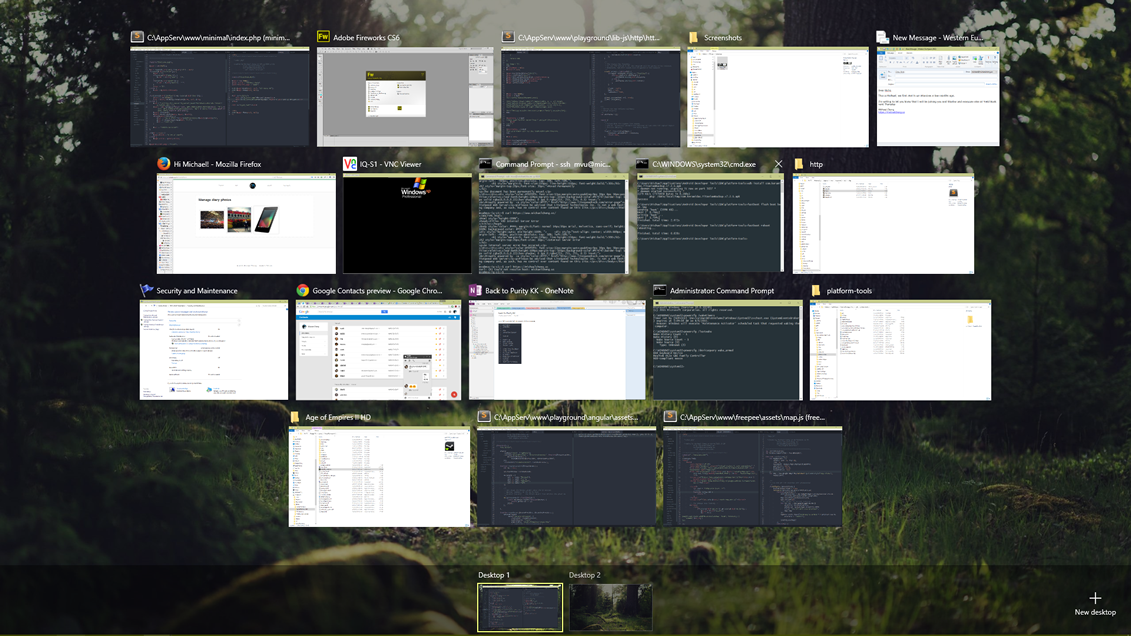07 Aug Some thoughts on today's operating systems
A few days ago, I decided to take the jump to Windows 10. I upgraded my laptop using the force update method (run `wuauclt.exe /updatenow` inside an elevated command prompt after deleting contents of the `C:\Windows\SoftwareDistribution\Download\` folder), and a few days later, I upgraded my PC using the [Windows Media Creation tool](http://www.microsoft.com/en-us/software-download/windows10). It's been a few days with the new operating system, and I definitely have to say it's very nice.
One of the first things I changed in Windows 10 was the login background. By default, it shows the blue Windows 10 background, which I don't like. To change that background to the accent color, just add a `DWORD` called `DisableLogonBackgroundImage` to `HKLM\SOFTWARE\Policies\Microsoft\Windows\System` in the registry. Change the value to 1.
The second thing I changed was the white title bars. This can be changed by applying a custom theme. More information on how to do this can be found [here](http://www.windowscentral.com/replace-those-white-title-bars-windows-10-colors-theme).
I really like the task view (Win+Tab), and although I always rather liked the Metro start screen, I _really_ like the new start menu.

But what I really want to say is, I'm impressed with the way Microsoft can bring a more modern OS to older devices and still have it run smoothly. My laptop is by no means old: it's a Core i5-3337U CPU with an SSD, but I was expecting some lag with the task view or the new animations. I think it's because of a very bad experience with the Nexus 7 (2012).

The Nexus 7 shipped with Android Jelly Bean. I bought the 32GB WiFi version and immediately rooted it and installed Paranoid Android. Using the tablet was always a peculiar experience. Sometimes it was fast, and sometimes it was painstakingly slow. Playing Asphalt 8 on it would be smooth, yet opening Chrome took 10 seconds. It was usable at best.
In the beginning of this year, I went through the tedious process of reformatting back to ext4 to install Android 5.0, or Lollipop. I was expecting a jump in performance, especially with the new Android Runtime. But what I got was an unresponsive tablet and massive lag. Waking the tablet induced so much lag that the screen would timeout before I could draw the unlock pattern. After turning on WiFi, the tablet would be unusable for at least 30 seconds before it could register any touches. Opening apps took an amazing amount of patience. If I needed to search for something on Google, I would find myself turning on the screen, swiping up to open Google Now, and waiting for what seemed like minutes before I could say "OK Google".
This horrendous performance seems to be attributed to the poor NAND storage used in the tablet. I turned off FSYNC, changed I/O schedulers, and ran TRIM twice a day. It seemed to get better, but not really. Yesterday, I decided to downgrade to KitKat. I miss the visual effects of Lollipop, but performance is just so much better with KitKat. I suppose if the Nexus 7 gets Android M, I'll find myself trying the newer OS, but I won't get my hopes up.
Comments
Since you took the jump with the force update, how is your driver support? I (thankfully) got my update prompt on day one, but a lot of people that went with the forced update method have reported driver issues.
I didn't get any driver issues actually. My laptop uses the integrated Intel graphics, so I didn't expect any problems there. My desktop, on the other hand, uses an AMD card, but I had no issues - which is nice. I'm assuming everything went fine on your end? :)
Good